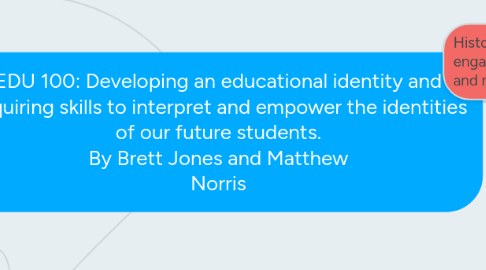
1. Sociological Perspective: Understanding and interpreting school environment and diversity in the classroom.
1.1. Developing Professional attitudes inside and outside of school
1.1.1. Mark Yurik presentation from the ATA, a formal view on how the province sees professsionalism,
1.1.2. Discussion Forums on Professional identity, identifying professionalism for ourselves as teachers but understanding the responsibilities that come with the authority of the job.
1.2. Students are shaped in our education systems, socialized by hidden curriculums.
1.2.1. Barakett, J. & Cleghorn, H. 2007. " The School as a informal system of socialization" , identifying the ways in which schools shape the future generation and aid in the uptake of societal values.
1.3. Creating inclusive and safe environments for sharing knowledge
1.3.1. LGBTQ presentation from ISMSS representative Malinda McNie, implementing environments that foster individuality and cherish self-representation/expression in all children.
1.3.2. Building Bridges Indigenous Knowledge Reading, incorporating and celebrating cultural differences in the classroom. Acknowledging that our default culture is not easily applicable to people with different cultures and ethnicities.
2. Philosophical Perspective: Defining teacher identity for ourselves and choosing what we value in the classroom.
2.1. Building and identifying the values and practises that will be utilized in your classroom
2.1.1. Philosophy Inventory, placing ourselves with particular philosophies on teaching and identifying teachers methods in regards to teaching philosophy
2.1.2. Assigned Reading: "Philosophy Chapter 2": identifies numerous philosophical perspectives we may choose to align ourselves with.
2.2. Facilitating philosophical dialogue
2.2.1. Picture Book Philosophy Thomas Wartenburg, introducing philosophical dialogue in engaging manner so kids understand its importance with efficient communication of ideas and discussion
2.2.2. "The Giving Tree" in class dialogue, exemplifying the techniques that can be used by students to inquire and live philosophical lives. Helping to open students perspectives to the diversities of individual interpretations.
2.3. Catering to varieties of learning styles within your classroom and combating curriculum from multiple perspectives
2.3.1. Blooms Taxonomy, theorized method of understanding a hierarchy to acquiring/mastering knowledge
2.3.2. Sir Ken Robinson's Video, working to broaden and include modes of learning that have not traditionally been accepted in schools. shifting to new paradigms in education.
3. Historical Perspective: Modern learning engagement in contrast/critique of historical events and methods
3.1. Dr. Frank Peters (Guest Lecture): Why does education in Canada look the way it does?
3.1.1. BNA Act
3.1.1.1. Education of "Indians" designated to federal government
3.1.1.2. Education is entrusted to each individual province.
3.1.1.2.1. Alberta's diverse educational institutions: private/public/charter/denominational/specialized
3.2. Surviving Eugenics (Video): Looking at Alberta's Eugenics program that spanned from 1928-1972
3.2.1. Michener Center
3.2.2. Alienation of a population
3.3. Class Discussion: Truth and Reconciliation Commision and the effects of Residential Schools
3.3.1. Inter-generational damage
3.3.1.1. Did not know the feeling of love and compassion
3.3.2. Cultural and Familial impacts
3.3.2.1. Loss of heritage
3.3.2.2. Lead to high levels of alcoholism and substance abuse.
